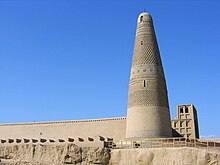| Emin Minaret | |||||||||
|---|---|---|---|---|---|---|---|---|---|
 Emin Minaret and Uyghur Mosque | |||||||||
| Chinese name | |||||||||
| Traditional Chinese | 蘇公塔 | ||||||||
| Simplified Chinese | 苏公塔 | ||||||||
| |||||||||
| Alternative Chinese name | |||||||||
| Chinese | 额敏塔 | ||||||||
| Literal meaning | Emin Minaret | ||||||||
| |||||||||
| Persian name | |||||||||
| Persian | مناره امین | ||||||||
The Emin Minaret or Emin Tower stands by the Uyghur mosque located in Turfan, Xinjiang, China. At 44 meters (144 ft) it is the tallest minaret in China.[1] The Qing Empire conquered this largely Muslim region in the 1750s by defeating the Dzungar Mongols with their superior weaponry in a series of battles. The Uyghurs under Emin Khoja joined the Qing Empire for protection against the Dzungars and the Emin minaret was named after Emin Khoja.
The minaret was started in 1777 during the reign of the Qianlong Emperor (r. 1735–1796) and was completed only one year later.[2] It was financed by local leaders and built to honor the exploits of a local Turpan general, Emin Khoja, hence the name "Emin".[3][4] The Emin Minaret is located along the ancient Silk Route (near the ancient Uyghur capital of Gaochang). Nearby is the site of the Bezeklik Thousand Buddha Caves.[5]
The arid landscape of southern Xinjiang has long been connected to both East Asia and West Asia by historical trade routes such as the Silk Road and the land around these crossroads became the location for most of the Uyghur Islamic structures in Xinjiang. The area has long served as a conduit for cultural exchange between different ethnic and religious groups. The Emin Minaret, like other Uyghur mosques and minarets, reflects this in its combination of traditional Islamic features and local Uyghur building traditions.[5]
- ^ "Amin Mosque". archnet.org. Archived from the original on 2010-12-14. Retrieved 2007-10-02.
- ^ "Emin Minaret (1777-1778)". orientalarchitecture.com. Retrieved 2007-10-01.
- ^ "Emin Minaret (Su Gong Ta)". travelchinaguide.com. Retrieved 2007-10-02.
- ^ Fischer, Klaus (1985). "Miscellanies on Less Known Islamic Buildings in Northern China". Rivista degli studi orientali. 59 (1/4): 99–101. ISSN 0392-4866. JSTOR 41880463.
- ^ a b Cite error: The named reference
sunwas invoked but never defined (see the help page).